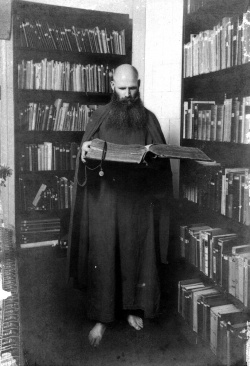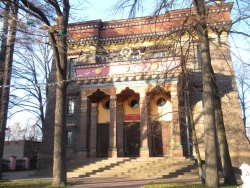The Beginning of Buddhism in Estonia: Karl Tõnisson
Estonia had been in the sphere of Christianity for many centuries when, in 1873, a man named Karl Tõnisson was born in the village of Umbusi in Estonia. He was, without doubt, the first to disseminate Buddhism in Estonia and in the Baltic countries and the first to openly declare himself a Buddhist. He was generally considered to be an exotic and colourful figure, and his lifestyle earned him the name “Barefooted Tõnisson”. He was also called Brother Vahindra, the Baltic Mahatma, Dharmaduta and, according to his passport, Karlis Tennisons.
Tõnisson studied philosophy in St Petersburg University and lived in the house of the oriental enthusiast E. E. Uhtomski, as Tõnisson’s father had been Uhtomski’s good friend for years. Tõnisson got acquainted with many people who visited Uhtomski’s house, including Agvan Dorzijev, the teacher of the 13th Dalai Lama and Baron Roman Ungern von Sternberg from Estonia.
In 1893, Tõnisson travelled to Buryatia for the first time to study Buddhism. He studied in Buryatia for years and so the history of Estonian Buddhism is directly connected with Buryatia and its Buddhist traditions.
Tõnisson travelled through Russia and Asia in the first decade of the 20th century. He was often in the Erden Dzuu Monastery and in Urgaa, where he stayed with HH Djebtsung Damba Hutukhta, who was the head of Mongolian Buddhists. In his journeys he often met with Dorjiev, Ungern von Sternberg and Tundutov, the people whom he already knew from St Petersburg.
He published his first book, Teaching about How a Human Becomes Immortal, in Russian, and it was published in Riga by G. Budberg’s printing house in 1909. In Tartu, he published his Buddhist verses in a book, in which, for the first time, he presented his version of Pan-Baltoonia, inspired by Pan-Mongolism.
In 1914, Tsar Nikolai II affirmed the staff of the St Petersburg Buddhist temple, which at first consisted of nine monks, of whom five had to be gelongs. From that moment on Tõnisson was connected with the St Petersburg Buddhist temple and was officially on the list of the temple’s staff, so he was seen as a valuable resource at the temple and was appointed the head of St Peterburg’s Buddhist temple by Dorjiev in 1920.
In 1923, Tõnisson left the St Petersburg’s temple to hide from the Bolsheviks after receiving a letter from Dorjiev, who asked him to leave the town, as staying in St Petersburg would have been dangerous. The Estonian embassy refused to give Tõnisson a visa or permission to come to Estonia, because the embassy was informed of his activities in the St Petersburg’s temple. Tõnisson went to the Latvian embassy and the Latvians provided him with the necessary papers and citizenship. Karl Tõnisson became the Latvian citizen and Buddhist cleric Karlis Tennissons, and as such later left a mark in the history of Asia.
Tõnisson arrived in Tartu with Latvian citizenship, where he gave lectures, published books and held lamaistic services in Kloostri Street. He also popularised exercise yoga and water procedures. In 1924, he organised the first Latvian Buddhist congregation in Riga, where he had a small temple-like structure in a rented building, where once a week he held a Buddhist service. When he was over 50 years old, Tõnisson participated in a marathon organised by the Estonian sports society “Kalev” in 1926 and finished in third place. It took him 3 hours, 31 minutes and 26 seconds, which was a very good time for a person of his age.
In 1925, he printed his book What the Buddhist Priest Tennison wants to Give to the Latvian People which described his own merits as a Buddhist monk. In 1928, he published Future Great Power Pan-Baltoonia and in 1930 Me and My Disciples Believe (published by Eduard Bergmann’s printing house in Tartu). In 1909–1930 Tõnisson published at least 16 books, including new editions: 13 in Estonian (six of them were original works), two in Russian and one in Latvian.
In the 1930s Tõnisson met his companion and student Friedrich Lustig.

